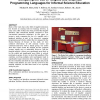Free Online Productivity Tools
i2Speak
i2Symbol
i2OCR
iTex2Img
iWeb2Print
iWeb2Shot
i2Type
iPdf2Split
iPdf2Merge
i2Bopomofo
i2Arabic
i2Style
i2Image
i2PDF
iLatex2Rtf
Sci2ools
CHI
2009
ACM
2009
ACM
Comparing the use of tangible and graphical programming languages for informal science education
Much of the work done in the field of tangible interaction has focused on creating tools for learning; however, in many cases, little evidence has been provided that tangible interfaces offer educational benefits compared to more conventional interaction techniques. In this paper, we present a study comparing the use of a tangible and a graphical interface as part of an interactive computer programming and robotics exhibit that we designed for the Boston Museum of Science. In this study, we have collected observations of 260 museum visitors and conducted interviews with 13 family groups. Our results show that visitors found the tangible and the graphical systems equally easy to understand. However, with the tangible interface, visitors were significantly more likely to try the exhibit and significantly more likely to actively participate in groups. In turn, we show that regardless of the condition, involving multiple active participants leads to significantly longer interaction times....
CHI 2009 | Human Computer Interaction | Tangible Interaction | Tangible Interfaces | Tangible User Interfaces |
Related Content
| Added | 24 Nov 2009 |
| Updated | 24 Nov 2009 |
| Type | Conference |
| Year | 2009 |
| Where | CHI |
| Authors | Michael S. Horn, Erin Treacy Solovey, R. Jordan Crouser, Robert J. K. Jacob |
Comments (0)

